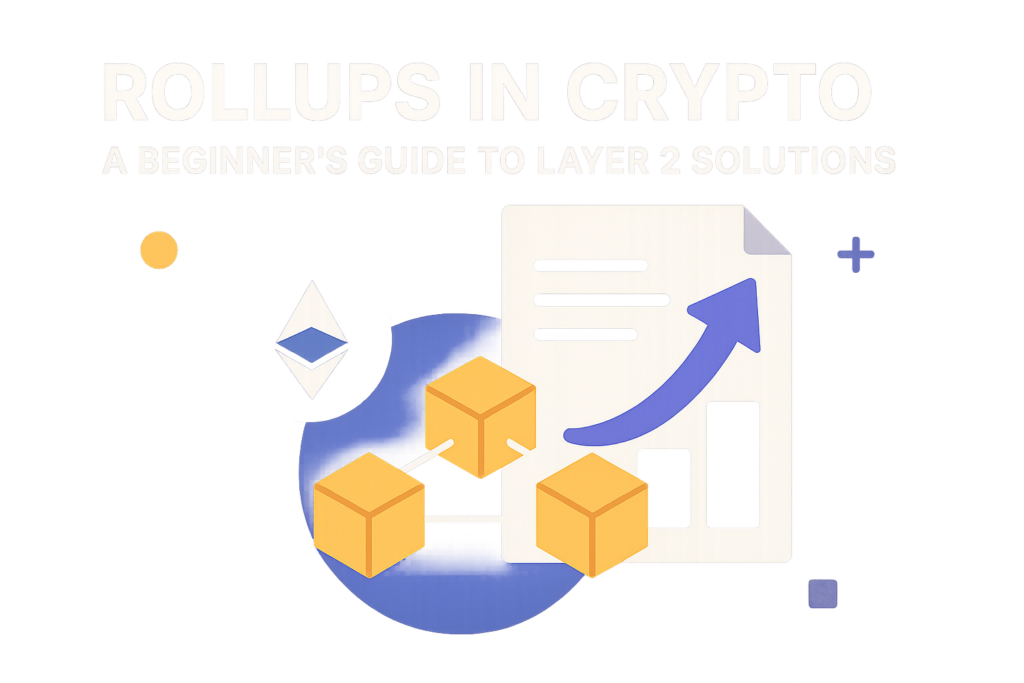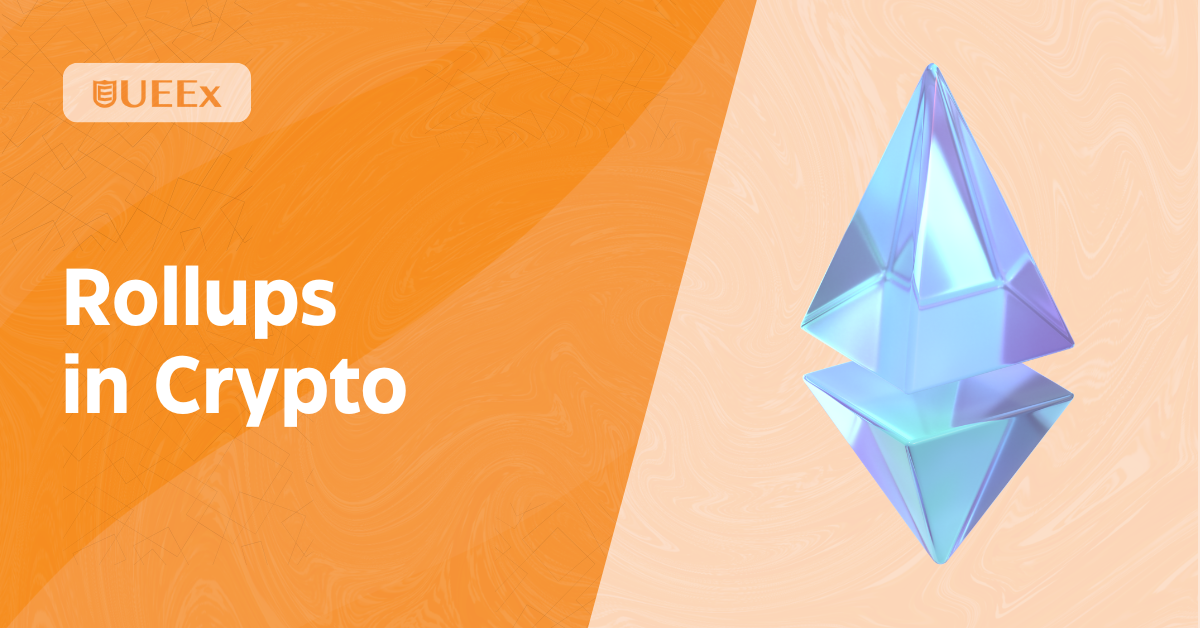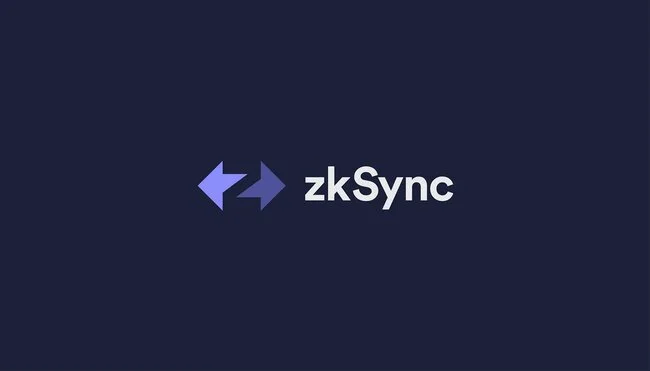If you’ve ever tried sending crypto during peak trading hours and found yourself waiting endlessly for the transaction to go through or worse, realized the fees cost more than the amount you sent, you’re definitely not alone.
As decentralized apps and blockchain finance gain popularity, networks like Ethereum face growing pressure to keep up. To address these challenges, developers have turned to innovative Layer 2 solutions called rollups in crypto.
Hence, these tools enable blockchains to process more transactions faster and cheaper, all while maintaining strong security. But what exactly are rollups, and why are they becoming essential for the future of decentralized apps? Let’s find out.
Key Takeaways
- Rollups are Layer 2 solutions that batch transactions off-chain and post them on Ethereum to reduce fees and increase speed.
- Rollups lower costs and transaction times, making DeFi trading, NFT minting, and blockchain gaming more accessible.
- The two main types of rollups are Optimistic Rollups (e.g., Optimism, Arbitrum) and ZK-Rollups (e.g., zkSync Era, StarkEx).
- Current challenges include onboarding complexity, withdrawal delays, and limited interoperability between different rollups.
What are Rollups in Crypto?

Rollups are a powerful Layer 2 (L2) scaling solution developed to tackle one of the biggest challenges facing blockchain networks like Ethereum: scalability. As popular Layer 1 (L1) blockchains grow, they often struggle with network congestion, slow transaction speeds, and high gas fees.
While Layer 1 solutions focus on the base blockchain itself, Layer 2 solutions like rollups work on top of these blockchains to improve performance without compromising security.
Rollups in crypto work by processing multiple transactions off-chain, outside of the main Ethereum blockchain, and then bundling or “rolling up” these transactions into a single, compressed batch. This batch is then posted back to the Layer 1 blockchain as one transaction.
By doing this, rollups effectively spread the gas fees across many users, significantly lowering the cost per transaction. Importantly, because rollups post their transaction data to Ethereum’s Layer 1, they inherit its robust security guarantees.
Any attempt to alter or revert a rollup transaction would require changing the Ethereum blockchain itself, which is practically impossible due to its decentralized nature. This means users get faster, cheaper transactions without sacrificing the security and trustworthiness that Ethereum provides.
Furthermore, rollups come in different types, such as Optimistic Rollups and ZK-Rollups, each using distinct methods to validate transactions. They have become especially valuable for decentralized finance (DeFi), gaming, and other applications where high throughput and low fees are critical.
Types of Rollups in Crypto
There are mainly two types of rollups in crypto, and they both handle transactions off-chain to reduce congestion and costs on Layer 1. However, they use different methods to verify the validity of these transactions.
Let’s take a look at them in more detail below:
Optimistic Rollups
Optimistic rollups are one of the earliest and most popular Layer 2 solutions designed to scale Ethereum and other blockchains. The core idea behind optimistic rollups is quite simple: they assume that all transactions processed off-chain are valid “optimistically.”
Thus, instead of verifying each transaction immediately, these rollups submit batches of transactions to the main Ethereum chain without upfront proof. Because they trust the transactions by default, optimistic rollups include a built-in safety mechanism called a “fraud proof” system.
This allows anyone to challenge a suspicious or potentially invalid transaction during a predefined window. Additionally, if the fraud proof is valid, the rollup system will revert the invalid transactions, maintaining the integrity of the network.
To discourage false challenges or bad behavior, both the challenger and the transaction submitter typically stake Ethereum as collateral, which they lose if they act dishonestly. Two of the most well-known optimistic rollup projects are Optimism and Arbitrum.
Their relative simplicity and compatibility with existing Ethereum smart contracts make them popular among developers and users alike.
Advantages
- Compatible with existing Ethereum smart contracts with minimal changes.
- Lower upfront computation cost compared to ZK-rollups.
Limitations:
- The dispute period can cause slower final transaction confirmation times (up to a week in some cases).
- Requires active monitoring by users or validators to submit fraud proofs.
Zero-Knowledge (ZK) Rollups
Unlike optimistic rollups, zero-knowledge or ZK-rollups take a fundamentally different approach to transaction verification. Instead of assuming transactions are valid and waiting for possible challenges, ZK-rollups generate cryptographic proofs called zero-knowledge proofs.
These ZK-proofs mathematically guarantee the correctness of every transaction batch before it’s posted on the Ethereum mainnet. Additionally, they are highly efficient and succinct, meaning they provide strong security assurances without requiring the entire transaction data to be published on-chain.
This reduces data size, lowers gas fees, and enables near-instant finality because there’s no need to wait for a challenge period. ZK-rollups are generally faster than optimistic rollups when it comes to confirming withdrawals and finalizing transactions.
However, they are also more complex to build and require sophisticated cryptographic technology. Examples of projects using ZK-rollups include zkSync Era and StarkEx by Starkware.
These projects have been especially popular in applications requiring high throughput and privacy, such as gaming, payments, and DeFi platforms.
Read Also: Ultimate Guide to Understanding Decentralized Finance (DeFi)
Advantages:
- Faster transaction finality since no waiting for disputes.
- Potentially lower fees due to the efficient data compression and validation.
- Increasingly supported by Ethereum’s roadmap for scalability.
Limitations:
- More complex to build and integrate, especially for smart contracts with complex logic.
- Ecosystem and tooling are still growing but advancing rapidly.
Use Cases of Rollups in Crypto
Below are some real-life cases of rollups in crypto showing how they are actively being used to scale blockchain applications:
Arbitrum
Arbitrum is the largest rollup and Layer 2 blockchain by total value locked (TVL). It uses optimistic rollup technology to scale Ethereum by batching transactions off-chain and submitting compressed data to Ethereum’s mainnet.
Arbitrum offers two L2 chains: Arbitrum One (EVM-compatible) and Arbitrum Nova (optimized for gaming and NFTs). This solution reduces fees and increases throughput while maintaining security through Ethereum’s consensus
Immutable X
Immutable X is a leading NFT marketplace that uses zk-rollups (specifically zk-SNARKs) to enable fast, affordable, and scalable NFT minting and trading on Ethereum.
This approach significantly reduces transaction fees and processing times compared to on-chain Ethereum transactions, making NFTs more accessible and practical for gaming, collectibles, and digital art sectors.
Optimism (OP Mainnet)
Optimism is another major Layer 2 solution launched in 2021, using optimistic rollups to scale Ethereum. It supports Ethereum’s Solidity programming language and uses single-round fraud proofs on Ethereum for security. Optimism has become a leading L2 player, helping decentralized applications run faster and cheaper.
Base by Coinbase
Base is Coinbase’s Layer 2 scaling solution launched in 2023, built on the OP Stack technology (used by most optimistic rollups).
It is now the second-largest L2 chain after Arbitrum, providing a scalable and developer-friendly environment for Ethereum dApps with reduced transaction costs
StarkNet
StarkNet, developed by StarkWare, is a zk-rollup Layer 2 network designed to offer low-cost and high-throughput transactions on Ethereum.
It provides a developer-friendly environment to migrate dApps to Layer 2, improving scalability and user experience while maintaining Ethereum’s security.
Why Rollups Matter to Everyday Crypto Users
Here are several reasons why crypto users need rollups in crypto:
Lower Transaction Fees
One of the biggest headaches for crypto users on Ethereum has been the high gas fees, sometimes costing more than the actual transaction. This makes small trades or NFT purchases uneconomical.
Rollups in crypto batch many transactions together and submit them as one to the main chain, spreading out the cost. This significantly reduces fees.
Faster Transaction Times
On congested blockchains like Ethereum, transactions can take minutes or longer to confirm, especially during busy periods. Rollups process transactions off-chain and only post compressed data on-chain, speeding things up considerably.
This means users can interact with dApps without frustrating delays. For example, NFT platforms like OpenSea using Arbitrum let users mint and trade NFTs with much faster confirmation times compared to the Ethereum mainnet, enhancing the user experience.
Improved Accessibility for New Users
Rollups in crypto lower barriers to entry by making blockchain more affordable and usable. This means more people worldwide can participate in DeFi, gaming, and NFTs without worrying about prohibitive fees or slow network responses.
Security Inherited from Layer 1
Unlike some scaling solutions that sacrifice security for speed, rollups post transaction data back to Ethereum Layer 1, inheriting its robust security.
This reassures users that their funds are safe even though transactions happen off-chain. This balance is crucial for trust in crypto services.
Limitations of Rollups in Crypto
While rollups bring many benefits, they also have some important limitations that you should be aware of.
User Onboarding and Complexity
Despite their benefits, many rollups in crypto require users to bridge assets from Ethereum to Layer 2. This process can be confusing and sometimes risky if users aren’t careful, leading to lost funds or mistakes. Wallet compatibility and managing multiple accounts add to the complexity.
Withdrawal Delays on Optimistic Rollups
Since optimistic rollups rely on a challenge period to detect fraud, withdrawing funds back to Ethereum can take up to a week. This delay is a pain point, especially during market downturns when users want quick access to their assets.
Fragmented Ecosystem and Interoperability Issues
There are several rollups in crypto which include Optimism, Arbitrum, zkSync, StarkEx, and more.
However, moving assets directly between different rollups is often complicated or impossible without going back to Layer 1 first. This fragmentation adds cost and friction, limiting a seamless user experience.
Technical and Development Challenges
ZK-rollups, while promising, involve complex cryptography that can limit the kinds of smart contracts supported, though this is improving.
Additionally, optimistic rollups require active monitoring for fraud proofs, which can complicate network maintenance and security assumptions. Developers must navigate these trade-offs carefully.
Read Also: The Popular Algorithms in Crypto Trading
Conclusion
As blockchain technology continues to evolve, scalability remains one of its most pressing challenges, and rollups in crypto are proving to be one of the most promising solutions. Rollups such as Optimistic Rollups are already reshaping how we interact with decentralized apps, from DeFi platforms to NFT marketplaces.
While they still face several limitations, ongoing innovations such as Ethereum’s upcoming updates (e.g., EIP-4844) and interoperability protocols signal a promising future. In the end, rollups in crypto are a step toward making blockchain truly usable for everyone, everywhere.
Frequently Asked Questions(FAQs)
What Exactly is a Rollup in Crypto?
A rollup in crypto is a Layer 2 scaling solution that processes many transactions off the main blockchain, bundles them together, and posts a compressed version back to Layer 1 to reduce fees and speed up transactions.
What’s the Difference Between Optimistic Rollups and ZK-Rollups?
The difference between Optimistic Rollups and ZK-Rollups is that Optimistic Rollups assume transactions are valid and allow challenges via fraud proofs, which can cause delays. However, ZK-Rollups use cryptographic proofs to verify transactions immediately, offering faster finality but with more complex technology.
What are the Main Challenges With Rollups Today?
Key challenges with rollups include the complexity of moving funds between Layer 1 and Layer 2, withdrawal delays (especially on optimistic rollups), and limited interoperability between different rollup solutions.
How do Rollups Maintain Security if Transactions Happen Off-chain?
Rollups post transaction data back to the main chain, inheriting its security. Fraudulent activity can be detected and reversed (in optimistic rollups), or validity proofs ensure correctness (in ZK-rollups).







